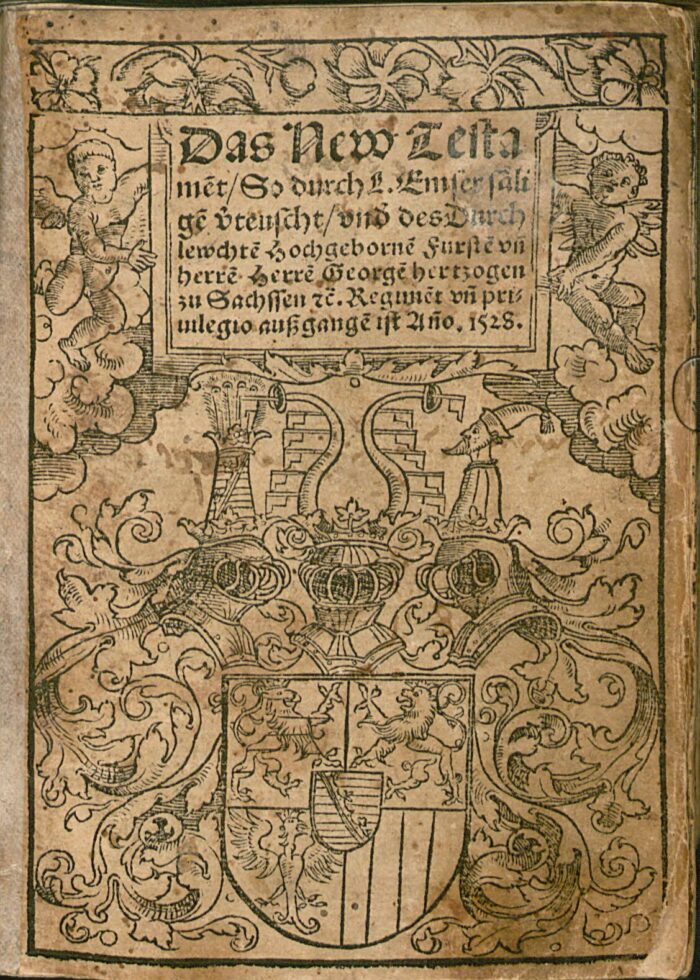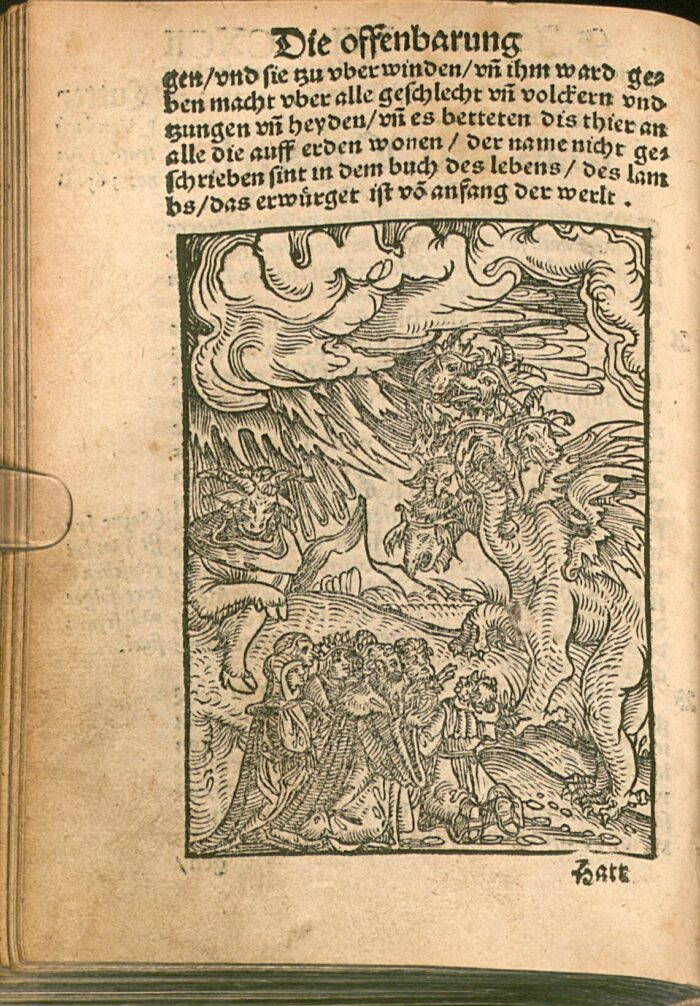Das New Testament / Testamentum novum
Das New Testament / Testamentum Novum
By Lusine Hambardzumyan and Anna Maria Hermann

|
Title
|
Testamentum novum / Das New Testament
|
|
Author
|
L. Emser
|
|
Date
|
1528
|
|
Place
|
Leipzig, Germany
|
|
Language(s)
|
German
|
|
Sources
|
Available on Münchener digitaliserungs Zentrum Digitale Bibliothek: https://www.digitale-sammlungen.de/en/view/bsb00085747?q=%28new+testament%29&page=920,921
|
|
Format
|
In-4 or in-2
|
Historical Context
- Roman Persecution of Christians: The late 1st century saw intermittent persecution of Christians. The Roman Emperor Domitian, who ruled from 81 to 96 AD, is often associated with a period of increased hostility toward Christians. While not a systematic empire-wide persecution, Domitian’s reign involved localized pressures, accusations of atheism (due to Christians’ refusal to worship Roman gods), and social ostracism. This hostile environment made the message of Revelation, with its imagery of suffering and deliverance, resonate deeply with persecuted Christians.
- Jewish Revolts and Roman Relations: The aftermath of the First Jewish-Roman War (66-73 AD) and the destruction of the Second Temple in Jerusalem (70 AD) also significantly influenced the socio-political landscape. Tensions between the Jewish communities and the Roman authorities remained high, and Christianity, initially seen as a Jewish sect, was affected by this strained relationship.
- Christian Eschatological Expectations: Many early Christians expected an imminent return of Christ and the establishment of God’s kingdom. This eschatological hope shaped much of the apocalyptic literature of the time, including Revelation. The imagery of beasts, dragons, and cosmic battles symbolized the struggle between good and evil, reflecting both spiritual warfare and the social-political challenges faced by the early church.
Purpose of the book
In 1528, the context of the book’s publication was deeply intertwined with the religious and political turbulence of the Protestant Reformation. The Reformation, initiated by Martin Luther’s Ninety-Five Theses in 1517, had rapidly grown into a movement that challenged the authority of the Catholic Church and reshaped religious, social, and political life in Europe. Luther’s translation of the New Testament into German (published in 1522) was a landmark event, as it made the scriptures accessible to a wider German-speaking audience, allowing laypeople to read the Bible in their native language.
Contrastive analysis of text and image

This woodcut image is an illustration of the passage from Revelation 13, capturing the vision of a monstrous beast rising from the sea, as described in the Bible. Here is a detailed analysis and description of the illustration, comparing it with the text:
Visual Analysis
1. The Beast with Seven Heads and Ten Horns: The dominant figure in the image is a multi-headed creature, which aligns with the beast described in Revelation 13:1-2. According to the passage, the beast has “seven heads and ten horns,” and each horn is crowned. In the woodcut, several heads are visible, each with distinct, grotesque features, symbolizing the diverse powers and the blasphemous nature of the beast as outlined in the scripture. The heads seem to carry crowns or be adorned, signifying authority and power, which the biblical passage mentions.
2. Diabolical and Animalistic Features: The beast depicted in the image seems to blend various animals, paralleling the description in Revelation, where the beast resembles a leopard, has bear-like feet, and a lion’s mouth. The creature’s overall form and rough, scaly texture are evocative of these symbolic elements, though the artist may have taken liberties in blending these features rather than representing them literally. The exaggerated features amplify its fearsome appearance, conveying the chaotic and evil essence associated with it.
3. Heavenly Clouds and Divine Wrath: The swirling clouds at the top of the illustration may represent the divine realm or the impending wrath that will befall the earth as a consequence of humanity’s adoration of the beast. In Revelation, the beast’s emergence marks a turning point, where it is given power and authority to blaspheme and wage war on the saints, and the clouds here may signify a separation between heaven and the corrupt world below.
4. Human Figures in Worship or Fear: At the base of the illustration, a group of figures stands with gestures of supplication or adoration toward the beast. This depiction aligns with the verse, “all that dwell upon the earth shall worship him” (Revelation 13:8), signifying the followers who will succumb to its power. The people appear either compelled or willingly reverent, capturing the sense of humanity’s awe or fear towards this terrifying power.
5. Imagery of Blasphemy and Idolatry: The text mentions “names of blasphemy” on the heads of the beast, symbolizing direct defiance against God. While not explicitly written here, the sense of blasphemy is visually implied through the beast’s crowned heads and the fact that people are seemingly in awe of it. This emphasizes the sinful worship and idolatry that Revelation condemns, with the image suggesting that humanity has been deceived into revering something opposed to divine will.
6. The Second Beast and Dragon: Although this specific image focuses mainly on the first beast, there are additional winged or serpent-like figures to the left that could hint at the dragon from Revelation 12 or the second beast from later in Revelation 13. The presence of these figures may represent additional forces of evil that support or are allied with the primary beast.
Comparison to Revelation 13
This image encapsulates the essence of Revelation 13 by visually interpreting the chapter’s symbolism and thematic elements such as:
– Power and Blasphemy: The crowns and multiple heads with grotesque, almost caricatured faces reflect the beast’s authority, while the text explicitly condemns its blasphemous nature.
– Human Adoration of Evil: The figures at the base reflect the prophecy that humanity will worship the beast, a sign of spiritual degradation.
– Divine Separation: The clouds above create a barrier, hinting at the distance between the divine and the corrupted earth, as humanity succumbs to evil forces.
Meet the Beast
https://bibleacrossnations.rarebook-ubfc.fr/wp-content/uploads/2024/11/The-beast-1.html
Bibliography
- Luther, M. (1517). The Ninety-Five Theses.
- Olin, J. C. (1999). Catholic Reform: From Cardinal Ximenes to the Council of Trent, 14951563
- Trent, Council of. (15451563). Canons and Decrees of the Council of Trent.
- MacCulloch, D. (2004). The Reformation: A History



